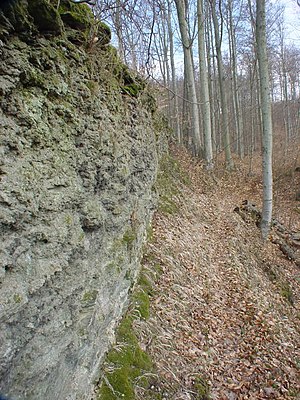Alt-Morungen Castle
| Alt-Morungen Castle | ||
|---|---|---|
|
Remains of the curtain wall and moat |
||
| Creation time : | around 1030 | |
| Castle type : | Hilltop castle | |
| Conservation status: | Wall and moat remains | |
| Standing position : | Count, Emperor | |
| Place: | Morungen | |
| Geographical location | 51 ° 30 '55.3 " N , 11 ° 13' 57.8" E | |
|
|
||
The Castle Alt-Morungen is the ruins of a hilltop castle about 500 meters west of the village Morungen , a district of Sangerhausen , in the state of Saxony-Anhalt . The castle was a small imperial ministerial castle . It has been in ruins since the 13th century. For a long time it was considered the original Morungen Castle and the birthplace of the minstrel Heinrich von Morungen .
The Höhenburg is an almost trapezoidal system of only about 20 by 30 meters on a rocky nose above the Bettelmannsbach. It is connected to the ridge to the east by a ridge that is cut by two unfinished ditches . The central castle grounds are surrounded by a deep moat carved into the rock and bordered in the north, east and south by the remains of the curtain wall .
The castle site is freely accessible.
history
The first news about the castle comes from the first half of the 11th century. A Count Goswin the Elder von Leige (Großleinungen) was named as the owner of Morungen. Around 1030 he gave the castle with all its accessories as a dowry to his daughter Sigena von Leinungen on the occasion of her marriage to Wiprecht, the lord of the Balsamer Land . Both sons were also called Wiprecht and went down in history as Wiprecht von Groitzsch . As a partisan of Heinrich IV and later Heinrich V , Wiprecht von Groitzsch initially gained great influence at the imperial court. Later, however, he and his son of the same name came into conflict with the imperial family. In order to release his son, who had been imprisoned since 1110, Wiprecht had to return his possessions in Morungen to Emperor Heinrich the V in 1112 . He enfeoffed Count Hoyer von Mansfeld with the castle. Only after the Battle of Welfesholz in 1115, in which the Saxon aristocratic opposition defeated the imperial and Hoyer fell, Wiprecht got his possessions back.
In 1157 the family of the Counts von Groitzsch sold the rule to Emperor Friedrich I. Around this time, the Lords of Morungen have been known as Burgmannen . The minstrel Heinrich von Morungen (1150-1220) came from this family. It is unclear whether his person is to be associated with old or new Morungen or both systems.
Around 1200 the castle was given up in favor of the newly built Neu-Morungen Castle and fell into disrepair.
New research, which takes into account a nearby siege hill and ceramic finds from the castle, suggest that the castle was planned as a neighboring castle to Neu-Morungen Castle in the 13th century. It was probably abandoned during the construction work, perhaps after a siege by Landgrave Albrecht of Thuringia in 1266.
Directly below the castle, about 80 m west of the stream that flows by there, there is a larger iron melting point with numerous slag. In the stream bed, the smelting area can be traced in a north-south direction to 20 m, the extent to the east cannot be determined without excavation, to the west it is limited by a mountain slope. At the foot of the slope there are smaller ore remains made of brown iron stone. After further searching, the ore mining was located approximately 1.5 km north of the castle. Due to the nature of the slag and molten wall remains, a connection between the smelting site and the castle is very likely.
literature
- Heinrich von Morungen . In: Meyers Konversations-Lexikon . 4th edition. Volume 8, Verlag des Bibliographisches Institut, Leipzig / Vienna 1885–1892, p. 326.
- Hermann Wäscher : Feudal castles in the districts of Halle and Magdeburg. 2 volumes. Henschelverlag Art and Society, Berlin 1962.
- Friedrich Stolberg: Fortifications in and on the Harz from early history to modern times. A manual (= research and sources on the history of the Harz region. 9). 2., unchanged. Ed. Lax, Hildesheim 1983, ISBN 3-7848-1002-X .
- Thomas Küntzel: “Under fire”. The siege of castles in the Harz during the 11th to 14th centuries. In: Castles and palaces in Saxony-Anhalt. Issue 16, 2007, ISSN 0944-4157 , pp. 265–284, here pp. 274 ff.


